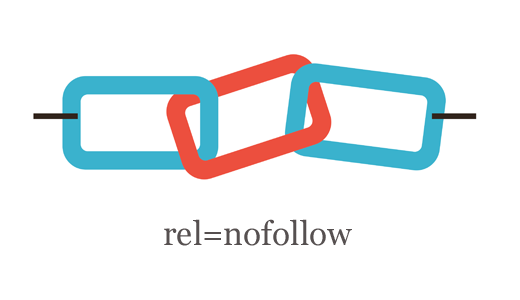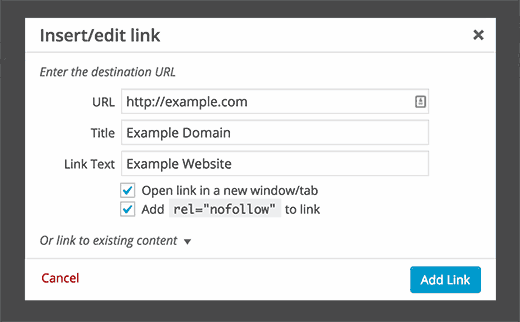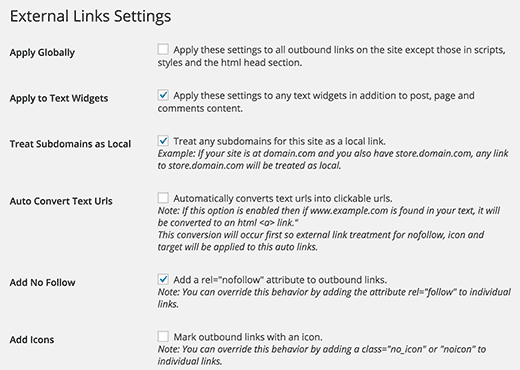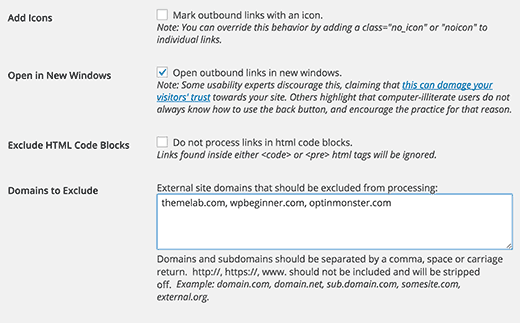¿Quieres nofollow enlaces externos en su sitio de WordPress? Aunque puede añadir fácilmente la etiqueta nofollow a enlaces individuales, ¿qué pasaría si quisiera hacer nofollow a todos los enlaces externos? En este artículo, le mostraremos cómo nofollow todos los enlaces externos en WordPress.
¿Por qué y cuándo es necesario no seguir todos los enlaces externos?

Los motores de búsqueda consideran los enlaces como una señal de clasificación para la URL y el dominio enlazados. Cuando enlazas a un sitio externo, estás pasando tu link juice a ese sitio.
El link juice es una especie de tarjeta de puntuación SEO. Si enlazas a más sitios que los que te enlazan a ti, empezarás a perder autoridad.
Esta es la razón por la que muchos expertos en SEO recomiendan utilizar el atributo nofollow.
Ejemplo de un enlazar con el atributo nofollow:
<a href="http://example.com" rel="nofollow">Sitio web de ejemplo</a>
Por defecto, WordPress no permite añadir automáticamente nofollow a enlaces externos. Tendrás que añadirlo manualmente a los enlaces salientes a sitios externos.
Una forma más fácil es utilizar el plugin Title and NoFollow For Links. Añade un campo de título y una casilla de verificación nofollow en el mensaje / ventana emergente de enlazar. Puedes hacer que los enlaces sean nofollow a medida que los añades.

Pero si tiene un sitio con varios autores, esto aumenta las posibilidades de que sus autores se olviden de marcar / comprobar la casilla para algunos enlaces externos. En este caso, necesita una solución que no requiera la intervención del usuario.
Dicho esto, vamos a ver cómo puede añadir nofollow a todos los enlaces externos en WordPress sin que sea necesaria la intervención del usuario.
Añadir NoFollow a todos los enlaces externos en WordPress
Lo primero que tienes que hacer es instalar y activar el plugin Enlaces Externos. Una vez activado, debe visitar la página Ajustes “ Enlaces Externos para establecer los ajustes del plugin.

La primera opción en los ajustes del plugin aplica nofollow globalmente. Puede mantenerla desmarcada si solo usted tiene acceso a los archivos de su tema.
Desplácese un poco hacia abajo y active la opción ‘Añadir Nofollow’ al hacer clic en la casilla de verificación situada a su lado. Esta opción añadirá nofollow a todos los enlaces externos en entradas y páginas de WordPress.
Hay un número de opciones en la página de ajustes que puedes activar.
Puede añadir nofollow a los enlaces de los widgets de texto de WordPress. También puede permitir que el plugin trate los subdominios como sitios locales y los excluya de las reglas nofollow.
External Links plugin también le permite abrir enlaces externos en una nueva ventana e incluso puede mostrar un icono a continuación de los enlaces externos.

Si tienes otros sitios web que quieres excluir de las reglas nofollow, puedes añadirlos en la sección ‘Dominios a excluir’.
No añada http o www y utilice comas para separar los dominios. Haga clic en el botón guardar cambios para establecer los ajustes.
Importante: Ten en cuenta que el plugin añade estos atributos sobre la marcha. Al desactivar el plugin se quitarán los atributos nofollow de todos los enlaces.
Eso es todo, esperamos que este artículo le haya ayudado a NoFollow todos los enlaces externos en WordPress. Puede que también quieras ver nuestra guía sobre cómo ocultar enlaces de afiliados en tu sitio WordPress.
Si te ha gustado este artículo, entonces por favor suscríbete a nuestro canal de YouTube para tutoriales en vídeo de WordPress. También puedes encontrarnos en Twitter y Facebook.





Jiří Vaněk
What concerns ‘nofollow,’ is it good to always use it, or make an exception for pages with very high authorit
WPBeginner Support
You could skip nofollow for high value sites for your articles but it is a question of testing and personal preference for which sites you don’t include nofollow for.
Admin
Christen Costa
Note: This plugin broke a number of our category pages as of June 2019. I’d be very careful. And by break, I mean the category pages were appearing blank.
WPBeginner Support
Thank you for letting us know, we’ll certainly take a look at the plugin and update the article once we find an alternative should it not be working.
Admin
Paul
Hi there,
Thanks for the help. I installed the External Links plugin. Quick question though. A lot of the links on my website are in the form of buttons, would the External Links plugin you suggested also work on these and make them nofollow? I assume it would as from my understanding it makes all outbound links no follow correct?
Thanks
Paul
Natasha
I thought you only had to make links no follow that would be earning a profit? Like affiliate links?
So, your saying ALL external links need to be no follow?
WPBeginner Support
Yes, unless those external links are to websites that you own and want them to benefit from a dofollow link.
Admin
Sagar Patil
Thank you very much, i used External links plugin.
Amit Singh
Hello,
Good Article. I have an issue regarding my wp site. inbound Link on posts or pages (only for posts / page. In sidebars, footer it works fine.) not working on small devices like mobile but working fine in computer. How to fix this issue. I am using WP External Link plugin but no result. I also used open external link wp plugin as i read in your site but not worked. Please help me to fix this issue.
Thanks
Dheeraj Tiwari
Thank you very much. It really helps me out!
Sandeep
I recently loss my ranking in google. I have a job alert website, i do everything correct but i use all externel links without no follow and next window..my website has approx 1000 externel links. Any idea to get back ranking in google? Please reply wpbeginner you are only hope for me…
WPBeginner Support
Hey Sandeep,
Please follow the instructions described in the article. With the help of ‘External Links’ plugin you will be able to add nofollow to all external links.
Admin
sean
I am using a plugin to no follow all external links. But sometimes I need to make a link do follow and for that I use rel= “do follow”. When I check, It showed both no follow and do follow.
What Should I do?
WPBeginner Support
You should see the documentation of the plugin you are using to nofollow all links. Plugin author may have described how to make some links do follow. If they haven’t, then you should ask them how to do that.
Admin
Usman
Thanks for help us by providing step to step guide.
Sheryl
I recently received a disturbing e-mail from Google saying:
Google has detected a pattern of links from your site to other sites that is either unnatural or irrelevant. This pattern attempts to artificially boost other sites’ ranking in Google Search results. Such unnatural ranking would cause search results to show preference for results not relevant to the user’s actual query. It also violates Google Webmaster Guidelines. Therefore, we are discounting the trust in links on your site.
I use Affiliate links in almost every post and I now have over 450 posts — If I have to manually code each link it will take forever to do…. Can I somehow get an explanation from Google on exactly what caused this action?
Thanks
Sheryl
Rodrigo
Any further feedback on the pros & cons of non-folliwing al-links? I haven’t made my mind yet. I just installed this plugin, but now, reading the comments, I wonder whether it was the right thing to do.
WPBeginner Support
Not all links. You should only apply no follow to external links. External links are those that take users away from your website to another website.
Admin
Rodrigo
Thank you!
Arize
Well, Thanks you should have said that earlier
Ted
I wish you had given us a real solution to do this. Adding, yet again, another plugin to fix the problem is not the right way to go.
Peter griffiths
I think it’s important to note that in almost all circumstances it’s not a good idea to no follow ALL external links as that completely defeats the purpose – it’s clear that Google thinks this too
A while ago I thought about using a plugin to do this but a website looks much more natural if you don’t do this. If you think about it it says to Google that all external links on the site are paid links, and if all links can be bought, how useful would they be for the visitor and a different site that doesn’t nofollow everything should be ranked higher as a result – correct me if I’m wrong though.
Gaurav Khurana
Good to know such kind of plugins exists which can help in such a nice way
Mickey
The idea of using nofollow to preserve link juice died in 2009. At this point, it costs you the link juice whether you nofollow it or not. Here’s some details from WooRank:
If you trust the link, let it be followed. Give them their credit back, because it’s the same to you either way. If you don’t trust the link, why do you have it on your blog at all?
Nofollow ads, of course, or anything user-generated (comments, etc), but anything else in your blog should be left open and followed.
Gaurang Thakor
Totally agree with you, sir!
Mark Corder
In SEO / NoFollow discussions, I’ve heard that having links to external sites that supplement your content is good, and that they should be allowed to “follow”. My photoblog has many external links, and most lead to official information associated with the photo I’m presenting – like State Park / Forest Service websites and Wikipedia articles.
Should I be marking these as NoFollow?
muncy
Opening links in a new window is not a good accessible practice.
Diamsy
Why do you say that it is not a good accessible practice?